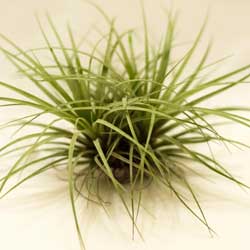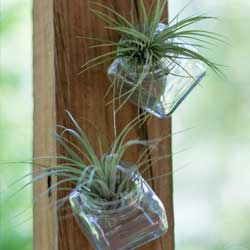Looking for something easy to grow? The air plant, Tillandsia, should be on the top of your list. Tillandsia is the largest genus in the Bromeliad family with over 550 species that vary in color, size, texture and shape. In its native habitat, it will attach itself to trees and rocks using its roots. The air plant derives the nutrients and water they need from the air, hence its common name. And guess what? No soil is necessary! This versatile houseplant is not fussy, and when given minimal care, will adapt to most home and office environments.
Light
Place your Tillandsia where it will receive plenty of light but not direct sunlight. Direct sun will dry out the leaves very quickly. Home or office fluorescent lighting works just fine.
Temperature
50 – 90 degrees Fahrenheit
Water
Once a month, soak your air plant in water for about 20 minutes. If the plant is flowering, a delicate rinse would be more appropriate so that the bloom is not damaged. When through soaking, shake off the excess water from the plant and place in an area with good air circulation. In between soaks, spritz it once a week with clean water from a spray bottle. Indoor heat and air conditioning rob moisture from the air. If the leaves of your air plant start to wrinkle or roll, this is a sign of dehydration. If this happens, give the plant a good soak and spritz it more than once a week.
General Maintenance
It is not unusual for the outer leaves of the air plant to dry out and turn brown, simply remove them. If leaf tips dry a bit and turns brown, cut the tip off and continue with regular care. The plant will grow and look just fine.
One final note, Tillandsias have beautiful brilliant blooms but only bloom once in their lifetime. Depending on the species, the bloom may last several days to several months.
Easy, right?








